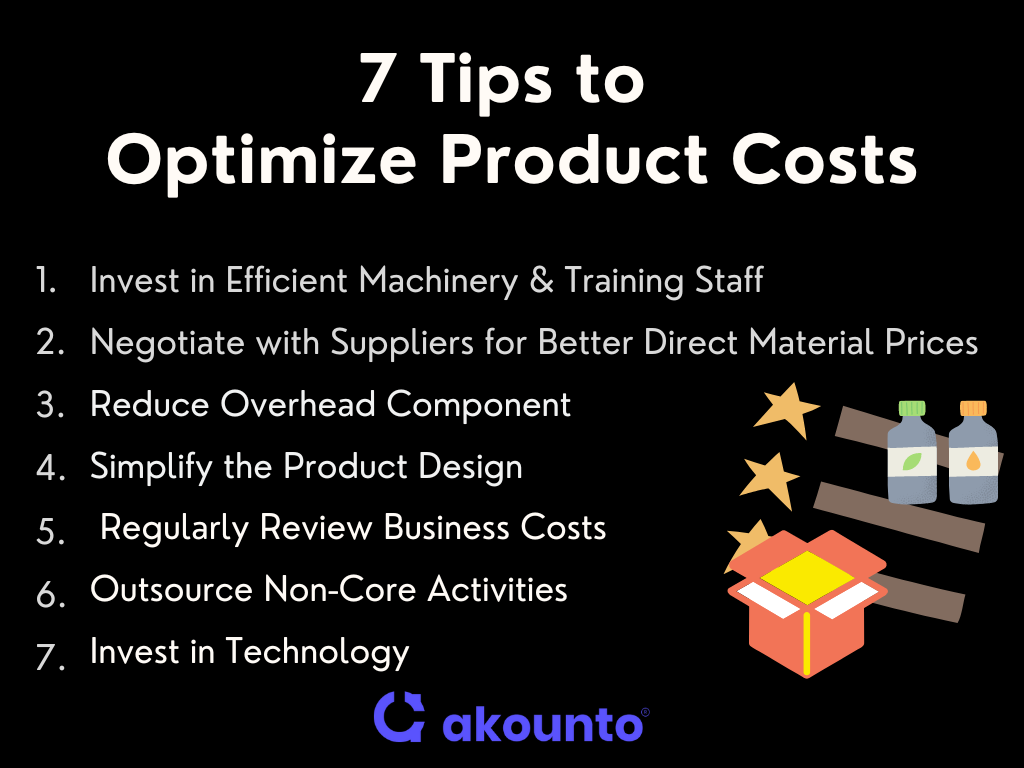Introduction
Product cost, a crucial concept in cost accounting, refers to the total expenditure incurred to manufacture a product. This includes direct materials, direct labor, and manufacturing overhead costs. The direct material cost is the expense of the raw materials used in the production process.
[ez-toc]
The number of units manufactured plays a significant role in determining the product cost. It helps calculate the per unit cost, which is the total cost of production divided by the number of units produced. This cost is essential in setting an appropriate sales price for the product, ensuring profitability while remaining competitive in the market.
Understanding the cost of production is vital not only for pricing decisions but also for financial reporting. It directly impacts a company’s income statement, as it forms a part of the ‘Cost of Goods Sold’ (COGS), affecting its overall profitability.
What Does Product Cost Tell?
Product cost is critical for financial reporting, pricing strategies, and operational efficiency. It provides a clear picture of the total costs associated with the production process, offering valuable insights for decision-making.
Product cost is used in cost accounting, providing valuable insights into a business’s financial health and operational efficiency. It encompasses all costs directly involved in producing a product, including raw materials, labor, and manufacturing overheads.
The unit product cost is a key metric that helps businesses set a competitive sales price. It ensures that all costs involved in production are covered and a profit margin is included.
Product cost also plays a pivotal role in the preparation of financial statements. It forms a significant part of the ‘Cost of Goods Sold’ (COGS) on the income statement, directly affecting the company’s gross profit and net income. A lower cost of production can lead to a higher gross profit margin, assuming the sales price remains constant.
Types and Examples
Product costs can be broadly categorized into Direct Materials, Direct Labor, and Manufacturing Overhead.
Direct Materials
Direct materials are the raw materials directly involved in the production process. These are the essential components that make up the final product. For instance, in a manufacturing facility producing furniture, the wood used would be considered a direct material.
Direct Labor
Direct labor refers to employees’ wages directly involved in the production process. This includes the workers on the assembly line who physically manufacture the product.
Manufacturing Overhead
Manufacturing overhead includes all the costs related to the production process that are not direct materials or direct labor. These costs are incurred in the manufacturing facility and are necessary for production but cannot be directly linked to specific units. Examples include factory rent, utilities, security guards, and cleaning supplies. Overhead also includes indirect costs such as consumable supplies used in the factory, like cleaning supplies and factory maintenance costs.
Examples
Here are some examples of each type of cost of production:
- Direct Materials: Wood in a furniture factory, fabric in a clothing manufacturing facility.
- Direct Labor: Wages of assembly line workers in a car manufacturing plant, salaries of chefs in a restaurant.
- Manufacturing Overhead: Rent for the manufacturing facility, utilities for the factory, payroll taxes, employee benefits, and the cost of indirect materials like cleaning supplies and factory maintenance costs.
Understanding these types of production costs is crucial for accurate cost accounting and effective management of production costs.
Formulae
Calculating the cost of production is a critical aspect of cost accounting. It involves summing up all the costs related to the production process.
Total Product Costs Formula
Total Product Cost = Direct Material Cost + Direct Labor Cost + Manufacturing Overhead Cost
Break down of each component:
- Direct Material Cost: This is calculated by multiplying the cost per unit of raw material by the number of units used in production.
- Direct Material cost = Cost per Unit of Raw Material x Number of Units Used
- Direct Labor Cost: This is the sum of all wages, salaries, and benefits provided to the employees directly involved in manufacturing.
- Direct Labor Cost = Sum of (Wages + Salaries + Benefits) of Direct Labor
- Manufacturing Overhead Cost: This includes all indirect costs related to the production process, such as indirect labor costs, indirect materials, and other costs like utilities, rent, and maintenance.
- Manufacturing Overhead Cost = Sum of all Indirect Costs
Examples
Example 1:
From the details from the bakery that manufactures gourmet cakes, calculate product cost.
- Direct Material Cost: The bakery uses ingredients costing $20 per unit and requires 5 units for a cake.
- Direct Labor Cost: The bakery pays its chefs $30 per hour, which takes 2 hours to bake a cake.
- Manufacturing Overhead Cost: The bakery incurs $40 in overhead costs, including utilities, rent, and indirect materials like baking paper and cleaning supplies.
Solution:
The total direct material cost is $20 x 5 = $100.
The total direct labor cost is $30 x 2 = $60.
Using the formula:
Total Product Cost = Direct Material Cost + Direct Labor Cost + Manufacturing Overhead Cost
The total product cost is $100 (Direct Material) + $60 (Direct Labor) + $40 (Overhead) = $200.
Example 2:
Cloth manufacturing costs:
| Cost Component | Cost per Unit | Units Used | Total Cost |
| Direct Material (Fabric) | $10 | 5 | $50 |
| Direct Labor (Tailor’s Wage) | $15 | 4 | $60 |
| Manufacturing Overhead (Utilities, Rent, etc.) | – | – | $30 |
Using the formula:
Total Product Cost = Direct Material Cost + Direct Labor Cost + Manufacturing Overhead Cost
The total product cost is $50 (Direct Material) + $60 (Direct Labor) + $30 (Overhead) = $140.
Example 3:
Calculate production costs in a toy manufacturing company.
| Cost Component | Item | Cost per Item | Quantity | Total Cost |
| Direct Material | Plastic | $2 | 50 | $100 |
| Paint | $1 | 100 | $100 | |
| Direct Labor | Toy Assembler’s Wage | $20 | 5 hours | $100 |
| Manufacturing Overhead | Utilities | – | – | $30 |
| Factory Rent | – | – | $20 |
Using the formula:
Total Product Cost = Direct Material Cost + Direct Labor Cost + Manufacturing Overhead Cost
The total product cost is $200 (Direct Material) + $100 (Direct Labor) + $50 (Overhead) = $350.
To calculate the product cost per unit, the company produces 10 toys:
Product Cost Per Unit = Total Product Cost / Number of Units Produced
The product cost per unit is $350 / 10 = $35 per toy.
Factors Affecting the Cost of a Product
- Direct Materials Cost: The cost of raw materials used in the production process directly affects the product cost. If the price of direct materials increases, the production cost will also rise.
- Indirect Labor: Indirect labor costs, such as the wages of maintenance staff, supervisors, and quality control personnel, can also impact product costs. These costs are part of the manufacturing overhead costs.
- Fixed Costs: Fixed costs, such as rent, insurance, and property taxes, do not change with the production level. These costs can significantly impact product costs, especially for businesses with low production volumes.
- Manufacturing Overhead Costs: These include indirect materials, utilities, factory overhead, and production supplies. These costs are necessary for manufacturing but cannot be directly attributed to a specific product unit. Any increase in these costs will increase the total product cost.
- Manufacturing Process: The efficiency of the manufacturing process can significantly affect the product cost. A more efficient process can reduce waste, decrease labor time, and ultimately lower the cost of production.
- Product Design: The product’s design can also affect the product cost. A complex design may require more materials and labor, increasing the cost of production.
- Market Conditions: Market conditions can affect the cost of raw materials and labor, affecting the product cost.
Product Costs and Business Decisions
- Pricing Strategy: The product cost forms the baseline for setting the selling price of a product. Businesses need to ensure that the selling price covers the product cost and leaves a margin for profit.
- Profitability Analysis: Product costs directly impact a company’s profitability. Businesses can increase their profit margins by reducing production costs, assuming the selling price remains constant.
- Budgeting and Forecasting: Accurate product cost information is essential for budgeting and forecasting. It helps businesses plan their finances, make investment decisions, and predict future profitability.
- Cost Control: Understanding the components of product cost helps to identify areas where they can control costs. This could be reducing waste in the production process, negotiating better prices with suppliers, or improving efficiency.
- Investment Decisions: Product costs can influence investment decisions. For example, if a product’s cost is too high, a business might decide to discontinue the product or invest in technology to reduce the cost.
- Financial Reporting: Product costs appear on the balance sheet as inventory and on the income statement as the cost of goods sold. Accurate product cost information is essential for accurate financial reporting.
- Operational Efficiency: Analyzing product costs can help businesses identify inefficiencies in their production process. This could lead to improvements in operational efficiency and cost savings.
7 Tips to Optimize Product Costs

- Improve Efficiency: Streamlining the manufacturing process can significantly reduce waste and labor required, lowering product unit costs. This could involve investing in more efficient machinery or training staff to improve their skills.
- Negotiate with Suppliers: Businesses can negotiate with their suppliers for better prices on direct materials. Buying in bulk or establishing long-term contracts can often lead to discounts.
- Reduce Overhead Component: Overhead costs, such as utilities and rent, can be substantial. Businesses can look for ways to reduce these costs, such as moving to a less expensive location or improving energy efficiency to reduce utility costs.
- Product Design: Simplifying the product design can reduce the required materials and labor, reducing production costs. This should be done without compromising the quality or functionality of the product.
- Outsource Non-Core Activities: Businesses can consider outsourcing non-core activities, such as accounting or HR, to reduce overhead costs. It helps businesses focus on core competencies and can often be more cost-effective.
- Regular Review of Costs: Businesses should regularly review their costs and look for areas where they can make savings. This includes direct costs, like raw materials and labor, and indirect costs, such as overheads.
- Invest in Technology: Investing in technology can often lead to long-term cost savings. For example, automation can reduce labor costs, and software can improve efficiency and reduce errors.
Conclusion
Product costs influence pricing strategies, profitability analysis, budgeting, and financial reporting. By effectively managing and optimizing product costs, businesses can enhance their operational efficiency, make informed decisions, and ultimately boost their profitability.
Sign up with Akounto for professional bookkeeping and accounting services!




